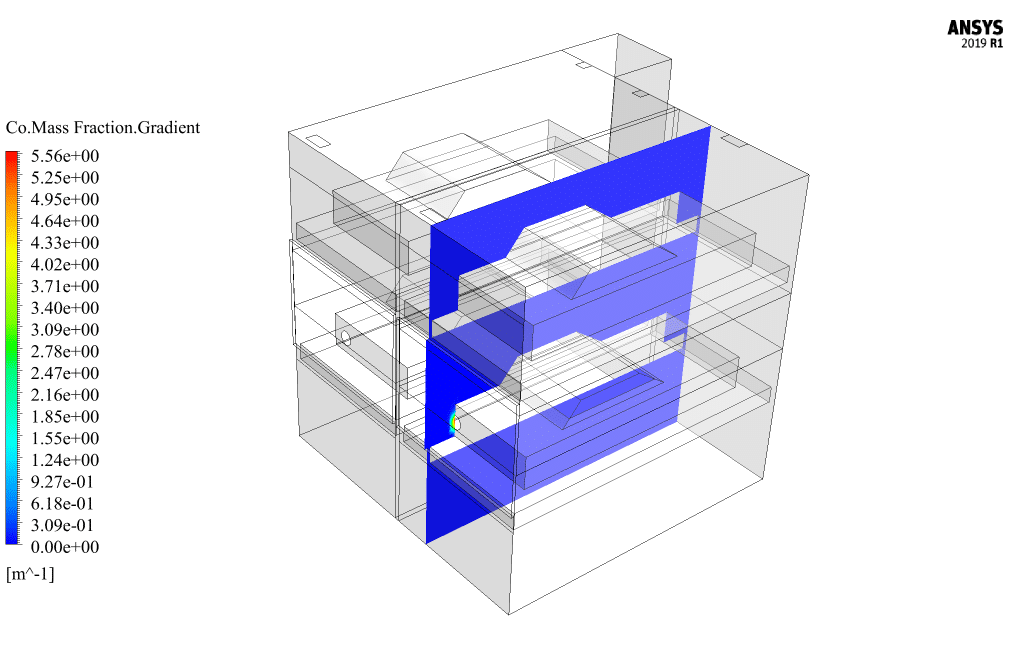Car Park (Stacker) Ventilation, ANSYS Fluent CFD Simulation Training
$240.00 $120.00 Student Discount
- The problem numerically simulates the ventilation inside the car park using ANSYS Fluent software.
- We design the 3-D model by the Design Modeler software.
- We Mesh the model by ANSYS Meshing software, and the element number equals 960365.
- We perform this simulation as unsteady (Transient).
- We use the Species Transport model to define different gases, including air and CO.
- We use a UDF to define the mass flow rate of pollutant gas from car exhaust.
To Order Your Project or benefit from a CFD consultation, contact our experts via email (info@mr-cfd.com), online support tab, or WhatsApp at +44 7443 197273.
There are some Free Products to check our service quality.
If you want the training video in another language instead of English, ask it via info@mr-cfd.com after you buy the product.
Description
Description
This simulation is about car park (stacker) ventilation via ANSYS Fluent software. We perform this CFD project and investigate it by CFD analysis.
In this project, stacker parking is designed, with three floors and two cars on two floors.
The structure of this type of parking lot is such that there are moving platforms on which the cars are placed, and then these platforms with the car are lifted vertically up between the two columns and placed at a higher height so that the space under it, for Provide the next car park on the lower platform.
The flow of carbon monoxide is emitted through the exhaust of two cars into the car park and pollutes its interior. This project aims to design a proper ventilation system to prevent the spread of pollutants and help eliminate these gases inside the car park.
Therefore, several special vents have been used on the car park’s roof. For air vents in the ventilation system, a value of zero for the mass fraction of carbon monoxide is used.
However, to define the boundary condition of these outlet vents, the inlet velocity condition is used, but the velocity value is applied as a negative value; Because the goal is to restrict the airflow inside the car park to be directed out through these vents at a certain speed.
To compare the performance of ventilation valves, the amount of suction power or the same amount of negatively defined velocity in these different output limits is considered. It has values equivalent to -1.25 m/s, -2.5 m/s, and -5 m/s.
The geometry of the present model is drawn by Design Modeler software. The present model is related to a multi-story stacker car park with a simple building, inside which four cars are designed.
Also, two borders on the exhaust ports of two cars are defined as a source of carbon monoxide emissions, and several borders are defined as special vents for air exits.
The model is then meshed by ANSYS Meshing software. The model mesh is unstructured, and 960365 cells have been created.
Car Park Method
In this simulation, the Species Transport Model has been used to model the release of carbon monoxide into the ambient air. So the number of gaseous species equals two, including air and carbon monoxide (CO).
Therefore, the exhaust outlet is defined as the inlet boundary condition; So that the mass fraction of CO is equal to one.
Also, because the emission of pollutant gas from the exhaust is a function of time, the simulation of this project has been done by a Transient solver.
A UDF is also used to define the mass flow rate of the emitted gas; Because, depending on the time, the flow rate of carbon monoxide can be zero or have a variable value.
Car Park Conclusion
After simulation, we represent the pathline of the carbon monoxide gas exiting the exhaust car manifold. In the mentioned ventilation system, several air intake vents have been used on the roof of the stacker to eliminate environmental pollution.
The car stacker consists of two separate parts with a dividing wall; each part has panels in the initial and final parts of the roof. In both the left and right parts, the incoming air enters from the filter wall of the parking wall behind the car exhaust and causes the exhaust gas to be emitted inside the parking area.
However, the carbon monoxide gas path will differ in the car park’s left and right parts.
On the right side, the suction power of the end panel (-1.25 m/s) is much less than the suction power of the front panel (-5 m/s), and therefore, the gas flow, despite its movement towards the end of the stacker, turns backward to be sucked out of the initial panel.
On the left side, the suction power of the end panel (-2.5 m/s) is less than the suction power of the front panel (-5 m/s). However, since the exhaust gas flow is to the end of the parking lot and, on the other hand, unlike the right side of the parking lot, the difference in suction power between the beginning and end of the stacker is not very significant.
The gas is expelled from the end panel to the outside parking space. Next, we obtain 2D and 3D contours related to velocity, mass fraction of carbon monoxide, mass fraction of air, and gradient mass fraction of carbon monoxide.
These contours clearly show that the carbon monoxide exhaust from the exhaust manifold inside the car park quickly disappears; Therefore, we can say that this ventilation system works well and prevents the significant spread of gas inside the stacker.
We should note that all results, including flow path lines and contours, were obtained at 5400 seconds.












Reviews
There are no reviews yet.